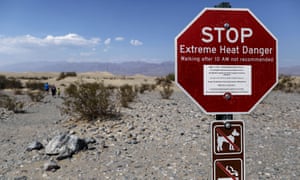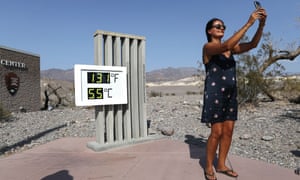Death Valley’s forbidding landscape registered a preliminary high temperature of 129.9F on 16 August. Don’t look away.

How hot was it at the Furnace Creek visitor center at Death Valley national park on 16 August 2020? It was so hot that the huge electronic temperature display (which serves as a ubiquitous selfie backdrop) went on the fritz. Parts of the blocky digital display malfunctioned, resulting in numbers even higher than the actual mind-melting high on what turned out to be a landmark day.
An automated weather station at the visitor center recorded a preliminary high of 129.9F (54.4C) at 3.41pm PDT on Sunday. Even for heat-favored landscapes such as Death Valley, it is remarkable for temperatures to inch into such territory so late in the summer, when the sun is considerably lower in the sky than at the summer solstice in late June. According to weather records researcher Maximiliano Herrera, the previous global record high for August is 127.9F (53.3C), recorded in Mitribah, Kuwait, in 2011.
If Sunday’s high at Death Valley is confirmed, it will be the planet’s highest temperature in almost a century and its third-highest on record, according to the World Meteorological Organization (WMO). Owing to the fact that the two higher readings are in question, it may, in fact, be the hottest air temperature ever recorded on Earth.
The 130F afternoon in Death Valley fits snugly in the “what next?” narrative of life in 2020. But because human-caused climate change is such a ubiquitous yet gradual process, it’s rarely at the top of the news. A surging societal issue will typically bump climate from the headlines. There’s been no lack of such US events in 2020, from the coronavirus pandemic to police brutality and the state of the US Postal Service ahead of the November elections.
Climate science, and common sense, warn that it would be unwise, however, to skip over what has just happened in the California desert.
While competing events jostle for our attention, the machinery driving the climate crisis lumbers onward. Even in a year when global carbon emissions are on track to dip by a few percent, thanks largely to reduced travel and shuttered workplaces, the total amount of carbon dioxide concentrated in the atmosphere will once again reach its highest value in millions of years, about half a percent more than in 2019.

The effects are perceptible. The Arctic experienced its first 100F day on record on 17 June when the Siberian town of Verkhoyansk hit 100.4F (38C). July 2020 was the hottest single month in more than a century of recordkeeping at such far-flung US locations as Phoenix; Miami; and Portland, Maine.
